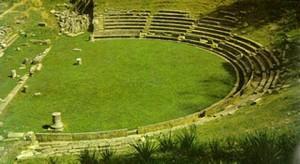|
Megalopolis Town

Megalopoli: The Ancient Theater |
Welcome to Megalopoli!
Here is how Professor N. Fields (University of Edinburgh) describes Megalopoli: On all gentle slopes there is good soil cover and the natural vegetation is comparatively luxuriant: at higher elevations cling fir trees, while lower down there are deciduous oak to be found. The one exception to all this ruggedness is the plain of Megalopolis, which lies in the heart of south-west Arcadia, a moderately hilly basin stretched either side of the Alpheios. The surface of this plain is diversified with copses and undulating downs and hillocks, refreshed by numerous streams shaded with plane trees and oak. Even with the arrival of the Megalopolis power-station complex and the recent expansion of the modern town, the whole plain is still notable for its sylvan beauty. (N. Fields [University of Edinburgh])
During the Cenozoic Era, the plain used to be a lake, and in Palaeontology excavations in 1902 a three meter long tusk was found. In 1959, almost two tons of fossilized bones coming from elephants, rhinos, hippos and other animals were found, now exhibited in the Museum of Palaeontology of Athens. Due to the existence of this lake, considerable lignite deposits were formed near the town. A big electricity producing plant was built on the spot, to take advantage of this energy source. As it is generally the case, here too some ecological issues have been raised.
Megalopoli has more than 5,000 inhabitants, a good part of them working at the electricity plant. It has three schools, lyceums, gymnasia, churches, banks, hotels, a post office and public squares. It also has a train stationwith a freight yard, 1 kilometer from downtown. The track is not through to Tripoli; the line for Kalamata – Tripoli –Argos is 4 kilometers south.

Megalopoli Plain from Dimitsana. |
|
|
|
|
|



